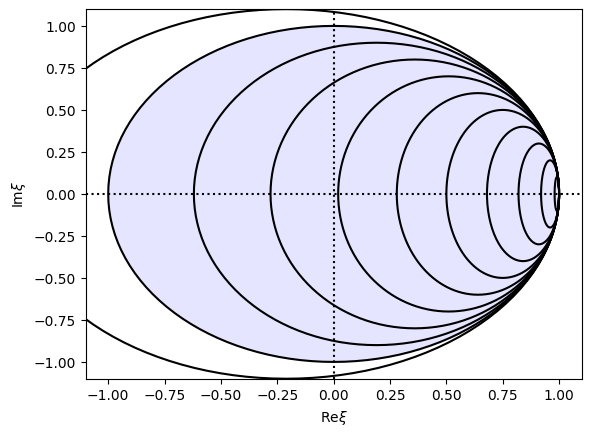Amplitude and phase errors#
import numpy as np
import matplotlib.pyplot as plt
from matplotlib.patches import Circle, PathPatch
The Lax-Wendroff update is
In this case, the von Neumann stability analysis gives
Notice that without the \(\alpha^2\) term, the update is always unstable, since we would then have \(|\xi|^2 = 1 + \alpha^2\sin^2 (k\Delta x)>1\). To investigate what happens when the \(\alpha^2\) term is included, let’s plot \(\xi\) in the complex plane:
n = 128
x = np.linspace(0,1,n)
dx = x[1]-x[0]
k = np.fft.fftfreq(n) * 2*np.pi/dx
fig, ax = plt.subplots()
plt.plot((-1.1,1.1),(0,0),'k:')
plt.plot((0,0),(-1.1,1.1),'k:')
circle = Circle((0, 0), 1, facecolor='blue',
edgecolor='none', linewidth=3, alpha=0.1)
ax.add_patch(circle)
for alpha in np.linspace(0.1,1.1,11):
xi_im = -alpha * np.sin(k*dx)
xi_re = 1 - alpha**2 * (1-np.cos(k*dx))
plt.plot(xi_re, xi_im, 'k')
plt.ylim((-1.1,1.1))
plt.xlim((-1.1,1.1))
plt.ylabel(r'$\mathrm{Im} \xi$')
plt.xlabel(r'$\mathrm{Re} \xi$')
plt.show()

The shaded region is the stable region (\(|\xi|\leq 1\)). The different curves are for different values of \(\alpha\). Changing \(k\) moves around one of the curves.
We see that \(\alpha=1\) gives \(|\xi|=1\) for all \(k\) vectors, since then \(\xi = \cos k\Delta x - i \sin k\Delta x = e^{-ik\Delta x}\). This corresponds to a translation of \(f(x)\) by an amount \(\Delta x\) (you can check that the update reduces to \(f_i^{n+1} = f_{i-1}^n\) when \(\alpha=1\).
For small \(\alpha\), \(\xi\) moves closer and closer to the point \((1,0)\). There is both an amplitude error (meaning \(|\xi|<1\)) and a phase error (\(\mathrm{arg}\,\xi\) depends on \(k\)).
This explains the much better behavior we saw for pure advection when \(\alpha=1\) compared to smaller \(\alpha\).
